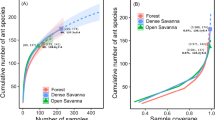Summary
-
1.
An account has been given of the changes that accompanied the gradual overgrowth of a glade in Spruce-Pine woodland. Although some small scale condensation into favourable nest-sites occurred, the general process was one of colony elimination and a reduction in mean nest density.
-
2.
The maximal nest density was of the order of 5 to 11 nests per m2 and the maximum economic density was 0.7 nests per m2. Whereas in a quadrat the 4-species population was aggregated, each species considered alone was either randomly distributed or overdispersed. No doubt this resulted from intra-species avoidance combined with interspecies indifference in a heterogeneous habitat and some relevant behaviour traits are considered.
-
3.
In general, the abundance of ants in the area is limited by lack of suitable nest sites.
Résumen
-
1.
Se ha tratado sobre los cambios que acompañan el crecimiento paulatino de yuyos sobre un claro dentro de un bosque de pinos y abetos. Auncuando occurrió en pequeña escala una condensación favorable para el sitio de nidos, el proceso en general fué de eliminación de colonias y reducción de la densidad de nidos.
-
2.
La densidad máxima de nidos fué de 5 à 11 nidos por m2 y la máxima densidad económica de 0.7 nidos por m2. Mientras que en un cuadrado fué agrada la populación de las cuatro especies, considerandola por separado, cada especie fué distribuida al azar o esparcida demasiadamente. Esto, sin duda, resulta de la costumbre de las especies de evadirse junto con la indiferencia de las mismas dentro de una habitación heterogénea y se consideran también rasgos de conducta pertinentes.
-
3.
En general, la abundancia de hormigas en el area se ve limitada por la escasez de sitios ideales para nidos.
Similar content being viewed by others
References
1954.Andrewartha (H. G.), Birch (L. C.). — The distribution and abundance of animals. Chicago University Press.
1949.Brian (M. V.), Brian (A. D.). — Observations on the taxonomy of the antsMyrmica rubra L. andM. laevinodis Nyl (Trans. R. ent. Soc. Lond.,100, 393–409).—Brian (M. V.), Brian (A. D.). 1951. Insolation and ant population in the West of Scotland (Trans. R. ent. Soc. Lond.,102, 303–330).
1951.Brian (M. V.). — Summer population changes in colonies of the antMyrmica. (Physiologia Comparata et Œcologia),2, 248–262).—Brian (M. V.) 1952. The structure of a dense natural ant population (J. Anim. Ecol.,21, 12–24).—Brian (M. V.) 1955. Food collection by a Scottish ant community (J. Anim. Ecol.,24, 336–351).—Brian (M. V.). 1956. Segregation of species of the ant genusMyrmica (J. Anim. Ecol.) (in press).
1954.Cochran (W. G.). — Some methods for strengthening the common χ2 tests (Biometrics,10, 417–451).
1927.Donisthorpe (H. J.). — British ants. London.
1932.Elton (C. R.). — Orientation of the nests of Formica truncorum F. in North Norway (J. Anim. Ecol.,1, 192–193).
1953.Kluyver (H. N.), Tinberger (L.). — Territory and the regulation of density in Titmice (Arch. Neder. Zool.,10, 265–289).
1954.Moore (P. G.). — Spacing in plant populations (Ecology,35, 222–227).
1952.Morisita (M.). — Habitat preference and the evaluation of the environment of an animal. Experimental studies on the population density of an ant-lionGlenuroides japonicus ML (Jap. J. Physiol. Ecol.,5, 1–16).
1954.Nicholson (A. J.). — Compensatory reactions of populations to stresses and their evolutionary significance (Aust. J. Zool.,2, 1–65).
1948.Raignier (A.). — L'économie thermique d'une colonie polycalique de la Fourmi des bios (La Cellule,51, 281–368).
1952.Skellam (J. G.). — Studies in statistical ecology, 1. Spatial pattern (Biometrika,39, 346–362).
1949.Solomon (M. E.). — The natural control of animal populations (J. Anim. Ecol.,18, 1–35).
1947.Steiner (A.). — Der Wärmehaushalt der einheimischen sozialen Hautflügler (Schweiz. bienen Ztg.,2, 139–256).
1943.Talbot (M.). — Population studies of the antPrenolepis imparis Say (Ecology,24, 31–44).—Talbot (M.). 1954. Populations of the antAphaenogaster (Attomyrma) traetae Forel, on abandoned fields on the Edwin S. George reserve (Contributions from the Laboratory of Vertebrate Biology, University of Michigan, number,69, 9 pp).
1929.Thompson (W. R.). — On natural control (Parasitology,21, 269–281).—Thompson (W. R.). 1939. Biological control and the theories of the interactions of populations. (Parasitology,31, 299–388).
1953.Way (M. J.). — The relationship between certain ant species with particular reference to biological control of the Coreid, Theraptus sp. (Bull. ent. Res.,44, 669–691).
1954.Yarrow (I. H. H.). — The British ants allied toFormica fusca L. (Hym. Formicidae) (Trans. Soc. Brit. Ent.,11, 229–244).—Yarrow (I. H. H.) 1955. The type species of the ant genusMyrmica Latreille (Proc. R. ent. Soc. Lond.,24, 113–115).
Author information
Authors and Affiliations
Rights and permissions
About this article
Cite this article
Brian, M.V. The natural density ofMyrmica Rubra and associated ants in West Scotland. Ins. Soc 3, 473–487 (1956). https://doi.org/10.1007/BF02226451
Issue Date:
DOI: https://doi.org/10.1007/BF02226451




